Orchids from Vietnam: how to grow at home?
Orchids have become one of the most popular indoor flowers. But the prices in the store bite on them. Bulbs often come to us from Vietnam. There it is an inexpensive and widely available flower. Growing an orchid is a lot different from caring for most common flowers.
Content:
Description and types
The beautiful name "orchid" actually means "egg". It is believed that the bulb of this plant looks like it. Orchids have a large, sturdy stem with one or more brightly colored flowers. Most often they are fragrant. The leaves are rounded, most often dark green.
Some species grow in soil, while others find shelter in trees.
They launch roots into the trunk of the tree, and the stem grows in the air. Tourists bring mostly terrestrial species. Orchids grow from so-called bulbs. Although in their qualities they are more like tubers or bulbs. Therefore, they are also called pseudobulbs.
Several types of orchids, called Pafiopedilums, are brought from Vietnam:
- Vietnamese, which is distinguished by a variety of flower colors. Its lower petal is especially beautiful. It has the shape of a shoe.
- Siamese, on the stem of which there is a pink flower with an admixture of green colors.
- Beautiful, whose petals are colored orange and green. Petals adorn dark dots and lines.
- Appletona has a large, fragrant flower combining brown and purple colors.
- One-flowered is the earliest. The flowers are fragrant, relatively small.
- The bearded one has a burgundy color, which is bordered by a light border. The lower petal is brown with red. The color of the leaves is not like other species. It is light, with dark spots.
- Elena is distinguished by the texture of the petal. They seem to be covered with a wax coating. On the peduncle are located one at a time. The color of the petals is yellow.
All these types of orchids differ in the color and size of the flower, their number on the peduncle, and the flowering period. But they all require the same care. Terrestrial orchids for sale in Ho Chi Minh City and Dalat.
Growing features
Seedlings or plants with roots are not immediately transplanted. Leave them to grow in the container in which they arrived until they no longer fit in it. Most often these are plastic bottles. Then transplanted.
When buying, it is advised to take a medium-sized onion. The small one will grow for a very long time until it blooms, and the large one will not live long. From planting a medium orchid bulb to when it first blooms, it usually takes 4 to 8 years.
Orchid bulbs brought from Vietnam, often without roots, sometimes they turn out to be dry. They are planted as soon as possible. For this:
- Prepare the dishes. A plastic bottle will work here too. Its transparent walls will allow you to observe the process of root formation. Holes can be easily cut in the walls so that air flows to the roots unhindered. You can use a plastic bucket made of food or technical materials. It is more stable than a bottle, but making holes in the walls is a little more difficult. A glass transparent pot designed specifically for growing this flower will be a beautiful dish for an orchid.But it is better to use it already for transplantation.
- At the bottom of the bottle, in which holes are made, large pebbles, for example, gravel, are placed. It will serve as a drainage and at the same time make the bottle more stable.
- Drainage from gravel is laid on top. Then the substrate is laid. It's easier to buy it at a flower shop. It consists of pine or spruce bark, coconut chips. Often sphagnum moss is used instead of bark. Add crushed coal, rockwool fibers and other materials that are not easy to find at home. You can not plant an orchid bulb in ordinary soil.
- The substrate is watered so that it is a donkey. An orchid bulb is installed, deepening it no more than 1 cm.To prevent it from falling, fix it with a stick.
- They are installed on a windowsill or other lighted place, and they wait for roots to form on it. The bulb has a sufficient supply of nutrients to form roots without moisture from the outside.
- Do not water until the roots appear and grow to the substrate. When this happens, water the onion for the first time. If you do this earlier, the orchid bulb will most likely rot.
After a while, adventitious buds will form on the upper part of the bulb, from which the stems will form orchids.
Transplanting an orchid
The orchid does not like frequent transplants. She perceives each of them as stress, so this operation should be approached with special attention. Quite frequent replanting of orchids is due to the fact that the substrate in which they live is very short-lived. Made from sphagnum moss, it loses its qualities in two years. Substrate with peat - in three. It thickens, its acidity changes. It is already difficult for air to penetrate to the roots in order to supply them with useful substances. Besides root system the orchid grows, and after a few years it no longer fits in the old pot. The growth of leaves and flowers slows down.
But sometimes you have to replant the orchid more often. This can happen with improper care, the presence peststoo much watering. In this case, the roots rot, and only a transplant can save the flower. Sometimes problems happen with the substrate. It starts to smell unpleasant. This smell also indicates the need for a transplant.
It is better to replant an orchid in spring.
Flower transplant rules:
- The dishes are taken the same, but with a slightly larger diameter. Disinfect her. Prepare or buy a substrate. Carefully remove the plant from the old pot. You need to do this so that the roots are not damaged. To do this, water the flower well and wait about half an hour until the moisture is absorbed. If after that the root system is not removed, donate the pot. The plant is dipped in a bowl or bucket of warm water so that all the old soil will lag behind the roots. This usually takes about half an hour.
- Examine the root system. If damaged roots are found, they are cut off, and the cut site is disinfected. You can do this by treating with charcoal. Damaged leaves are also removed.
- They carefully examine the roots of the orchid to see if any pest has wound up on them. They are quite small, so it is not easy to spot them. If pests are found, soak the root part in a disinfectant solution or filtered warm water.
- Remove dried leaves, old dried pseudobulbs. The cut sites are disinfected. The root part is dried for about 8 hours.
- The orchid is immersed in a new dish, at the bottom of which a layer of drainage and substrate has already been poured. Gently add the remaining substrate by shaking and tapping the pot. This will help fill in any voids. The substrate must not be strongly compacted. As a result of transplantation, the root collar should be one centimeter below the edge of the pot, but not in the ground, but above it. It is not necessary to immerse all air roots in the substrate.
Install the pot on the east window, away from direct sunlight. Maintain the room temperature at about 22 ° C.After transplanting, the orchid is watered after 4 days. Make sure that moisture does not get to the top where the growth point is located.
Orchid care
Orchids from Vietnam thrive in high temperatures and high humidity. The place where they are located should be sunny. But in summer, the direct rays of the sun should not hit the leaves. Therefore, the orchid located on the south window needs to be shaded in the summer. Better yet, place it at some distance from the window. When grown on a north window, there will not be enough light in winter. Therefore, you will have to illuminate with a fluorescent lamp.
For an orchid, you need to create conditions as close as possible to the tropics.
An orchid should be grown at a temperature of at least 18 ° C. At the same time, it should not rise above 20 ° C at night. The air must be humid. It is desirable to keep the humidity within 60 ° C. The orchid is fed once a month with a special agent for orchids. Water the orchid only after the substrate in which it grows is completely dry. You can see this thanks to the transparent dishes in which it is grown. Watering more often will cause the roots to rot.
Watering best done in the morning. Then by the evening the stem and leaves will dry out. Watering is carried out by sprinkling. They transfer the orchid to the bath, irrigate it with a stream of water at a temperature of about 40 degrees under a slight pressure until the entire soil becomes wet. It is left in the bath for a while so that excess moisture escapes through the holes.
More information can be found in the video:
The orchid can be watered differently. Set the plant pot in a tall bowl or bucket. The water should cover the top holes in the pot. Leave in a bowl for a while. Moisture will penetrate through the holes and moisturize the substrate. Then they are taken out and placed in a bath or at the bottom of an empty bowl so that excess water is glass. Installed in a permanent place.
Bringing orchids to fresh air is not recommended, even in summer.
Orchids from Vietnam can be affected by pests common to other plants:
- Thrips. The defeat manifests itself in the form of light streaks, which eventually merge into spots. The plant is isolated, washed with a stream of water, then treated with an insecticide.
- Nematodes (roundworms), which lead to leaf drying and deformation. Leads to the death of the plant.
- Ticks that leave dots at the puncture sites of the leaf blade. The leaves turn brown and die off.
You can find pests that have settled in the substrate by lowering the pot with the plant in soda. Some of the insects will float to the surface.



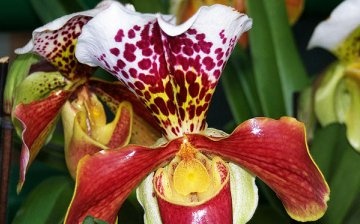
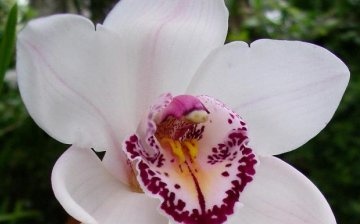
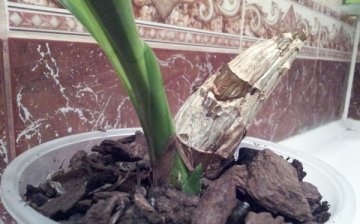
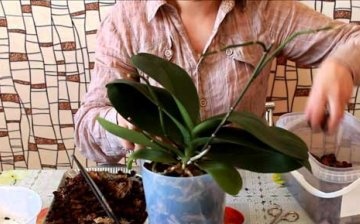
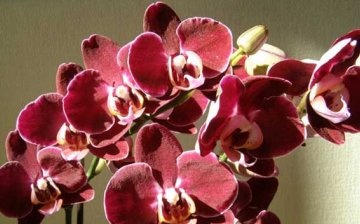





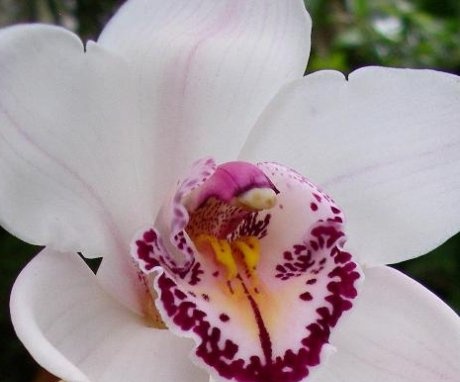
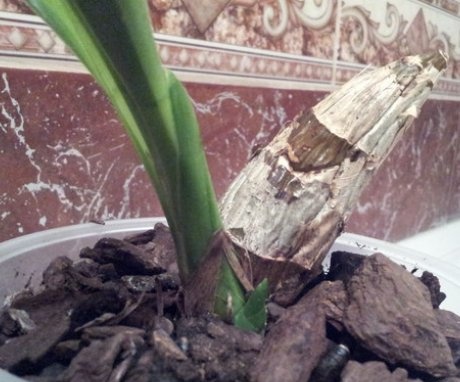
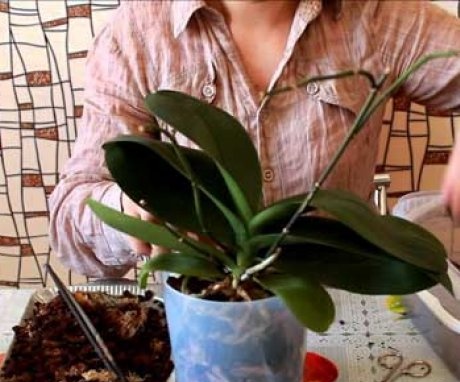
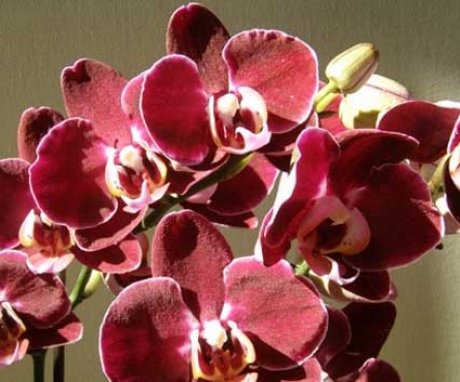
An orchid grows in our apartment, and although it looks like a photo of Vietnamese orchids, it is a phalaenopsis. I think that the ear behind him is about the same. If the flower below has more than four leaves, then this means that watering is excessive and the plant may begin to rot.